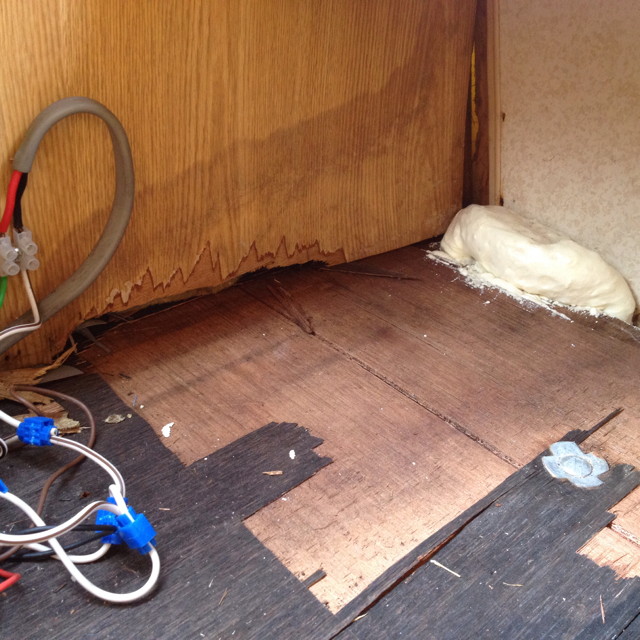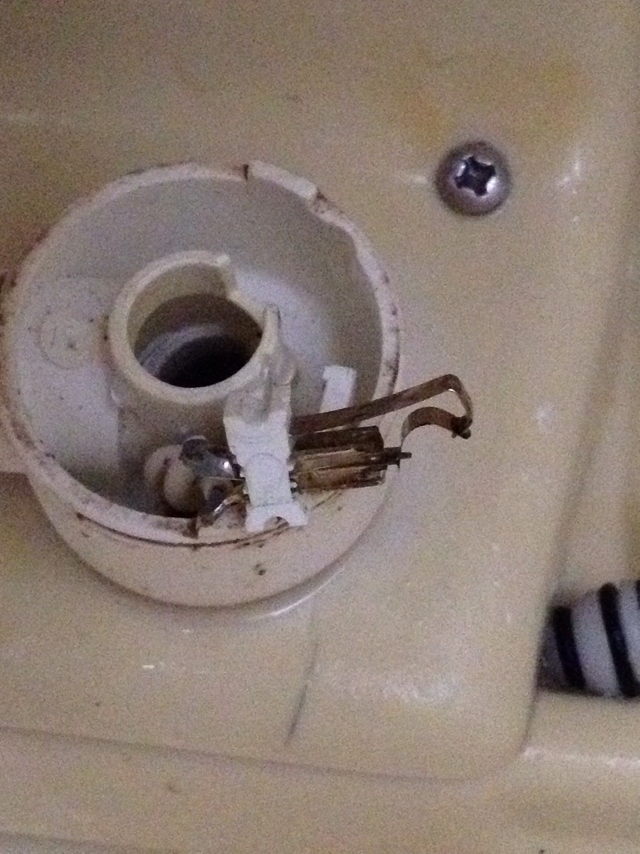Do you need to repair a damp caravan like we do? If so, read along with us to find out we are going about fixing the problem.
First some history
In “Fixing ABI Jubilee Rallyman taps” I introduced the need to perform some radical restoration surgery on our 1987’ish ABI Jubilee Rallyman.
When we bought the van, we knew there had been a damp problem because the seller told us so. It was also obvious, as the picture below shows.
However, the van was dry and there were no obvious signs of bodged repair jobs so we assumed it was a one-off and bought it.
At the start of this season however, we noticed there was condensation inside the van. This was strange as there was plenty of air circulation during the winter. Inspection revealed a serious damp problem in the floor inside the front right locker, as shown below.
 After removing the vinyl floor covering, which also removed the top layer of the underlying plywood floor (!) I dug out quite a bit of sodden flooring before finding sound, dry wood. I then dried the van out with a fan heater and put the temporary foam plug in the hole that you can see in the ‘photo.
After removing the vinyl floor covering, which also removed the top layer of the underlying plywood floor (!) I dug out quite a bit of sodden flooring before finding sound, dry wood. I then dried the van out with a fan heater and put the temporary foam plug in the hole that you can see in the ‘photo.
A couple of weeks ago we stripped the wall covering from inside the top right over-locker to reveal…
 Yuk! You can’t really see it in the ‘photo, but the surface ripples! A damp meter confirmed the problem: damp, a lot of damp.
Yuk! You can’t really see it in the ‘photo, but the surface ripples! A damp meter confirmed the problem: damp, a lot of damp.
After finding that the damp extended to the whole right hand wall forward of the wardrobe, we knew we had a choice: repair or ditch. The ‘van only cost £650, and would only be worth peanuts if we sold it. We decided to repair it to the best of our abilities. We’re both pretty handy and I reckon we can fix just about anything. Today was day one.
Research, research, research!
My abiding principle in business is that you shouldn’t re-invent wheels: the chances are that somebody has been there before. Thus, whenever I have a problem I start researching on the Internet.
Google is your friend
Pretty quickly, I found ukcampsite.co.uk and it’s Fixed It Club Members Directory. In there I found a site where somebody was repairing a damp problem with an ABI ACE Pioneer. The ACE Pioneer is of similar vintage to the Jubilee Rallyman and was built using very similar techniques. This site was a goldmine.
Anyway
Prior to starting, I had to spend yesterday making space in the garage to take all the bits that are being removed from the ‘van. I also purchased a cheap cover for the van:
- to keep it from any further damage; and
- to keep it sealed when I remove the windows.
Repairing a damp caravan, day one
I started by removing all the soft furnishings and loose fittings and then removed the curtain rails, coving and cupboard doors. The fact that many of the screws just pulled out is an indication of the extent of the problem.
We now hit snag number one
The top right over locker needs to come out. But how? I have removed the brackets that hold it to the wall, the screws that hold it to the wardrobe and the screws that attach it to the front shelf, but it won’t move. Prodding with a fine knife reveals that it is either screwed or nailed to the ceiling. Unfortunately, I can’t find the heads. It appears to have been put in place before the outer skin was attached. Really?
I’ve started to lever it down a bit to create a space to get a single-ended hacksaw in and saw through the screw/nail, but I am concerned about side effects.
I’ve asked a question in UKCampsite.co.uk and will wait to see if anybody has a suggested way forward. In the meantime, I’ve put a fan heater in there to start the drying out process.





